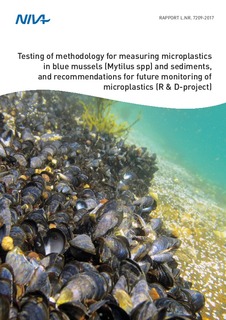| dc.contributor.author | Lusher, Amy | |
| dc.contributor.author | Bråte, Inger Lise Nerland | |
| dc.contributor.author | Hurley, Rachel | |
| dc.contributor.author | Iversen, Karine | |
| dc.contributor.author | Olsen, Marianne | |
| dc.contributor.other | Olsen, Marianne - Project manager | |
| dc.coverage.spatial | Norway | nb_NO |
| dc.date.accessioned | 2017-12-11T12:56:12Z | |
| dc.date.available | 2017-12-11T12:56:12Z | |
| dc.date.issued | 2017-12 | |
| dc.identifier | 7209 | |
| dc.identifier.issn | 0803-625X | |
| dc.identifier.issn | 1894-7948 | |
| dc.identifier.uri | http://hdl.handle.net/11250/2470297 | |
| dc.description.abstract | Miljødirektoratet tasked NIVA to investigate methods used for the extraction of microplastics from environmental samples of blue mussels and marine sediment. Presented here are the results of methods tested, as well as NIVAs recommendations for future monitoring of microplastics in the Norwegian environment. Based on the current literature and this study, Mytilus spp. appears to be a promising bioindicator for the smallest sized microplastic (<1 mm) in the water column. However, improvements are still required to optimise mussel surveys for quantitative monitoring surveys of Norwegian coastal environments. Steps required include optimising the number of individuals analysed, investigating the role of mussel size, investigating the impact of collection depth and exposure to air as well as inter-site variation between mussel populations. Blue mussels alone should not be the only environmental matrix monitored for microplastic pollution. Sediments are proposed as the final destination of most microplastics in the environment. Hence, monitoring of sediment seem to be appropriate and important for long-term trends. However, due to the complexity of sediment analysis, it might be more suitable to use sediment dwelling organisms, such as worms and/or bivalves feeding off/in the sediment. Methods for sediment sampling and further microplastic analysis require further optimisation and testing. | nb_NO |
| dc.description.sponsorship | Norwegian Environment Agency / Miljødirektoratet | nb_NO |
| dc.language.iso | eng | nb_NO |
| dc.publisher | Norsk institutt for vannforskning | nb_NO |
| dc.relation.ispartofseries | NIVA-rapport;7209 | |
| dc.relation.ispartofseries | Miljødirektoratet-rapport;M-897/2017 | |
| dc.rights | Navngivelse-Ikkekommersiell-DelPåSammeVilkår 4.0 Internasjonal | * |
| dc.rights.uri | http://creativecommons.org/licenses/by-nc-sa/4.0/deed.no | * |
| dc.subject | Plast | nb_NO |
| dc.subject | Menneskeskapt forsøpling | nb_NO |
| dc.subject | Forurensning | nb_NO |
| dc.subject | Overvåkning | nb_NO |
| dc.subject | Plastics | nb_NO |
| dc.subject | Anthropogenic debris | nb_NO |
| dc.subject | Contamination | nb_NO |
| dc.subject | Monitoring | nb_NO |
| dc.title | Testing of methodology for measuring microplastics in blue mussels (Mytilus spp) and sediments, and recommendations for future monitoring of microplastics (R & D-project) | nb_NO |
| dc.type | Research report | nb_NO |
| dc.rights.holder | Norsk institutt for vannforskning / Norwegian Institute for Water Research | nb_NO |
| dc.subject.nsi | VDP::Matematikk og Naturvitenskap: 400 | nb_NO |
| dc.source.pagenumber | 87 | nb_NO |
| dc.identifier.cristin | 1525555 | |

